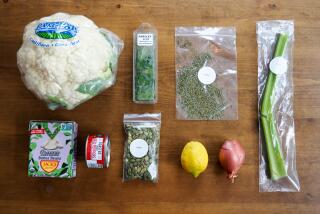Supermarkets to Target Unsafe Food
- Share via
CHICAGO — Supermarket executives at the annual convention of their trade association this week announced the creation of a task force to deal with contamination threats because, in the words of the group’s vice president, “nothing is more important than food safety.”
The program is being organized by the Food Marketing Institute, whose members operate 21,000 supermarkets with combined annual sales of $220 billion--more than half of all food grocery sales in the country.
“I cannot overemphasize the importance of retailers taking responsibility for food safety,” said Daniel R. Wegman, chair of FMI’s task force and president of Wegmans Food Markets in Rochester, N.Y. “For years, we have sidestepped that obligation, saying it is the job of government and suppliers to protect the food supply. Perhaps that was enough in the days before we learned about the widespread presence of microbes in the food supply that require special measures to detect and eliminate.”
Wegman’s extraordinary concession came in a major presentation to the convention titled “Speaks ‘96: The State of the Food Marketing Industry.”
For decades, grocers have been content to operate under a simple formula: “Stack it high and sell it cheap.” That was before the rise of incidents of food-borne illness linked to such organisms as salmonella and E. coli 0157:H7. The creation of the food safety task force underlines how seriously food retailers are taking the potentially devastating consequences of a drop in consumer confidence like the recent furor over mad cow disease in Europe.
In an opinion survey commissioned by FMI, more than nine in 10 consumers (92%) regard food safety as important when they shop.
“As the last link in the supply chain, we can provide the final safety checks before food products reach consumers’ hands,” Wegman said. “We also have more direct contact with consumers than any other industry segment. This provides us with excellent opportunities to help teach our customers about proper food handling and sanitation practices.”
The task force is compiling voluntary guidelines for use throughout the industry that will focus on handling and storage of fresh food, prepared foods such as ready-to-eat meals, placing more rigorous specifications on suppliers to guarantee product safety and more aggressive consumer education programs.
Wegman also pointed out that in the highly competitive supermarket industry, grocers should refrain from using food safety as a marketing tool against each other. “When one of us has a problem with customers’ health,” he said, “all of us have a problem.”
*
A different sort of competition has been more troubling for the nation’s supermarket chains, namely the battle for consumers’ food dollars among markets, fast-food outlets and full-service restaurants. Of particular concern is the supermarkets’ inability to cash in on the takeout phenomenon.
According to the recent FMI survey, only 12% of customers shopping for prepared food would most often choose a supermarket. That’s down from 17% in 1995. By comparison, 48% turn to fast-food chains and 25% to full-service restaurants. The remainder are split among gourmet shops, convenience stores and delis.
Consumers list several reasons they don’t purchase ready-to-eat meals at supermarkets, including a belief that the food has been sitting around too long, a lack of knowledge about the ingredients used in preparation and inconsistent quality.
“It’s worth noting that the cost of food away from home increased at a lower rate than food at home for the third straight year [2.3% versus 3.3%],” said Michael Sansolo, FMI vice president. “That might be due to the ongoing competitive battles among fast-food outlets and could impact supermarkets trying to win back some of those meals. After all, how do you compete with a 99-cent burger value meal?”
Even so, supermarkets’ investments in takeout or prepared foods are expected to increase significantly. At present, 63.3% of the markets report selling prepared foods; that figure is expected to climb to 76.9% by year-end.
More to Read
Eat your way across L.A.
Get our weekly Tasting Notes newsletter for reviews, news and more.
You may occasionally receive promotional content from the Los Angeles Times.









